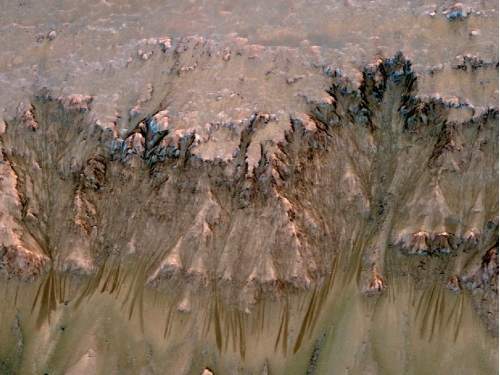Debate over the origin of large-scale polygons on Mars continues even after several decades of detailed observations – as similarity in geometric patterns on the red planet and Earth have long sparked the imagination.
Recently, geologists at the University of Texas at Austin examined the large-scale Martian polygons and compared them to similar features on Earth’s seafloor – which they believe may have formed via similar processes.

Through meticulous examination of THEMIS, MOLA, Viking, and Mariner data and images, planetary scientists have determined that areas on the northern plains of Mars are divided into large polygon-shaped portions and that sets of these polygons span extensive areas of the Martian surface.
Smaller polygon-shaped bodies are found elsewhere on Mars, but these are perhaps best explained by thermal contraction processes similar to those in terrestrial permafrost environments and quite unlikely to form larger polygons.
On Earth, polygon-shaped areas, with the edges formed by faults, are common in fine-grained deep-sea sediments. Some of the best examples of these polygon-fault areas are found in the North Sea and the Norwegian Sea. These are imaged using detailed, 3D seismic surveys conducted to search for offshore oil and gas deposits.

Although the details of deep-sea polygon formation on Earth are complex, Lorena Moscardelli and her colleagues conclude that the majority of these polygons form in a common environment: sediments made up of fine-grained clays in ocean basins that are deeper than 500 meters, and when these sediments are only shallowly buried by younger sediments.
A key observation – also made recently by Michelle Cooke at the University of Massachusetts – is that the physical mechanism of polygon formation requires a thick, wet, and mechanically weak layer of sediment.
In addition, Moscardelli and colleagues concluded that the slope angle of the sea floor plays an important role in both the formation and preservation of these polygons. Meaning, where the seafloor slope is very gentle (slopes less than half a degree), the polygons have very regular shapes and sizes.

In many locations where polygons have formed on top of buried topographic features on the seafloor, the shapes of the polygons were altered, and in some cases were broken up and disrupted where the slopes were steepest. Both observations are consistent with deformation of the soft marine sediments as they creep or flow downslope in these areas.
Indeed, in the northern plains of Mars, where the surface is basically flat, the polygons have very regular shapes and sizes – remarkably similar to the deep-sea polygons found on Earth. In places where the topography on Mars is more varied, and where there may be evidence for other sediment-transport features on the surface, areas of deformed and disrupted polygons can be found – again similar to the disrupted polygons here on Earth.

On the basis of these striking similarities, the University of Texas at Austin team concludes that these features most likely share a common origin and were formed by similar mechanisms in a similar environment. The team argues that the Martian polygons were formed within a thick, wet, and weak layer of fine-grained sediments that were deposited in a deep-water setting, similar to the Earth polygons.
As such, the geometric features may provide additional evidence for the existence of an ocean in the northern portion of Mars approximately three billion years ago.






